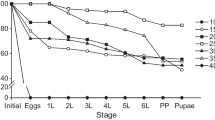Abstract
Developmental thresholds and thermal requirements for development of post-dormancy larvae of Monochamus galloprovincialis (Olivier) (Cerambycidae; Monochamini) were studied at ten constant temperatures ranging from 7 to 35°C. The relationship between temperature and development duration in days was linear between 15 and 30°C (r 2 = 0.98). The lower threshold for development was determined to be 12.2 ± 0.8°C and an average of 822 degree-days (DD) above that value was required for 50% adult emergence under laboratory conditions. The rate of larval development decreased above 30°C and the lethal upper threshold was between 32 and 35°C. Degree-day rate summation was initiated in the first of March and model predictions were validated with records of field emergence for the years 2001 to 2004. The modified sine wave predicted median emergence with an average error of 3.8 days from emergences in the field and a zero-day difference for two of the years. Model predictions were always within 10% of actual observed emergences. Predictions for early emergences (cumulative percentiles 1 and 10) were less accurate than predictions for median and late emergencies. The results suggest that a simple linear method driven by air temperatures can predict the emergence of M. galloprovincialis with sufficient accuracy to improve the pest management programmes currently implemented on the pine wilt disease affected zone in Portugal.

Similar content being viewed by others
References
Allen JC (1976) A modified sine wave method for calculating degree days. Environ Entomol 5:388–396
Arnold CY (1959) The determination and significance of the base temperature in a linear heat unit system. J Am Soc Hortic Sci 74:430–445
Arnold CY (1960) Maximum–minimum temperatures as a basis for computing heat units. J Am Soc Hortic Sci 76:682–692
Baskerville GL, Emin P (1969) Rapid estimation of heat accumulation from maximum and minimum temperatures. Ecology 50:514–517. doi:10.2307/1933912
Campbell A, Frazer BD, Gilbert N, Gutierrez AP, Mackauer M (1974) Temperature requirements of some aphids and their parasites. J Appl Ecol 11:431–438. doi:10.2307/2402197
Campbell A, Mackauer M (1975) Thermal constants for development of the pea aphid (Homoptera: Aphididae) and some of its parasites. Can Entomol 107:419–423
Evans HF, McNamara DG, Braasch H, Chadoeuf J, Magnusson C (1996) Pest risk analysis (PRA) for the territories of the European Union (as PRA area) on Bursaphelenchus xylophilus and its vectors in the genus Monochamus. EPPO Bull 26:199–249. doi:10.1111/j.1365-2338.1996.tb00594.x
Francardi V, Pennacchio F (1996) Note sulla bioecologia di Monochamus galloprovincialis (Olivier) in Toscana e in Liguria (Coleoptera Cerambycidae). Redia (Firenze) 79:153–169
Gilbert N, Raworth DA (1996) Insects and temperature—a general theory. Can Entomol 128:1–13
Higley LG, Pedigo LP, Ostlie KR (1986) DEGDAY: a program for calculating degree-days, and assumptions behind the degree-day approach. Environ Entomol 15:999–1016
Jikumaru S, Togashi K (1996) Effect of temperature on the post-diapause development of Monochamus saltuarius (Gebler) (Coleoptera: Cerambycidae). Appl Entomol Zool (Jpn) 31:145–148
Kishi Y (1995) The pine wood nematode and the Japanese pine sawyer. Thomas Company Limited, Tokyo
Linit MJ (1988) Nematode–vector relationships in the pine wilt disease system. J Nematol 20:227–235
Mota M, Braasch H, Bravo MA, Penas AC, Burgermeister W, Metge K et al (1999) First report of Bursaphelenchus xylophilus in Portugal and in Europe. Nematology 1:727–734. doi:10.1163/156854199508757
Naves PM (2007) Biology of Monochamus galloprovincialis (Coleoptera, Cerambycidae) and its role as vector of the pine wood nematode Bursaphelenchus xylophilus (Nematoda, Parasitaphelenchidae) in Portugal. Ph.D. Thesis. University of Lisbon, Portugal
Naves P, Camacho S, Sousa E, Quartau J (2007a) Transmission of the pine wood nematode Bursaphelenchus xylophilus through feeding activity of Monochamus galloprovincialis (Coleoptera; Cerambycidae). J Appl Entomol 131:21–25. doi:10.1111/j.1439-0418.2006.01111.x
Naves P, Sousa E, Quartau J (2007b) Winter dormancy of the pine sawyer Monochamus galloprovincialis (Coleoptera, Cerambycidae) in Portugal. J Appl Entomol 131:669–673. doi:10.1111/j.1439-0418.2007.01228.x
Obrycki JJ, Tauber MJ (1981) Phenology of three coccinellid species: thermal requirements for development. Ann Entomol Soc Am 74:31–36
Pruess KP (1983) Day-degree methods for pest management. Environ Entomol 12:613–619
Quesada-Moraga E, Santiago-Álvarez C (2000) Temperature related effects on embryonic development of the Mediterranean locust, Dociostaurus maroccanus. Physiol Entomol 25:191–195. doi:10.1046/j.1365-3032.2000.00185.x
Roltsch WJ, Zalom FG, Strawn AJ, Strand JF, Pitcairn MJ (1999) Evaluation of several degree-days estimation methods in California climates. Int J Biomet 42:169–176. doi:10.1007/s004840050101
Sousa E, Bravo M, Pires J, Naves P, Penas A, Bonifácio L et al (2001) Bursaphelenchus xylophilus (Nematoda; Aphelenchoididae) associated with Monochamus galloprovincialis (Coleoptera; Cerambycidae) in Portugal. Nematology 3:89–91. doi:10.1163/156854101300106937
Sousa E, Naves P, Bonifácio L, Bravo M, Penas A, Pires J et al (2002) Preliminary survey for insects associated with the pine wood nematode Bursaphelenchus xylophilus in Portugal. EPPO Bull 32:499–502. doi:10.1046/j.1365-2338.2002.00597.x
Tauber MJ, Tauber CA (1976) Insect seasonality: diapause maintenance, termination, and postdiapause development. Annu Rev Entomol 21:82–107. doi:10.1146/annurev.en.21.010176.000501
Teixeira LAF, Polavarapu S (2002) Phenological differences between populations of Rhagoletis mendax (Diptera: Tephritidae). Environ Entomol 31:1103–1109
Tomminen J (1993) Development of Monochamus galloprovincialis olivier (Coleoptera, Cerambycidae) in cut trees of young pines (Pinus sylvestris L.) and log bolts in southern Finland. Entomol Fenn 4:137–142
Acknowledgments
We would like to thank Mr. Rui Andrade for helping in obtaining the wood material and Mrs. Célia Ferreira (Tróia Resort, Sonae Turismo) for supplying the weather readings for Tróia. Drª. Lurdes Santos (EFN) kindly allowed us to use the temperature incubators to rear the insects. Thanks are also due to Prof. Dr. JA Quartau (FCUL, Lisbon) for reviewing the manuscript. This work was partially funded by the European Phrame project QLK5-CT-2002-00672.
Author information
Authors and Affiliations
Corresponding author
Additional information
Communicated by A. Juen.
Rights and permissions
About this article
Cite this article
Naves, P., de Sousa, E. Threshold temperatures and degree-day estimates for development of post-dormancy larvae of Monochamus galloprovincialis (Coleoptera: Cerambycidae). J Pest Sci 82, 1–6 (2009). https://doi.org/10.1007/s10340-008-0210-4
Received:
Revised:
Accepted:
Published:
Issue Date:
DOI: https://doi.org/10.1007/s10340-008-0210-4




